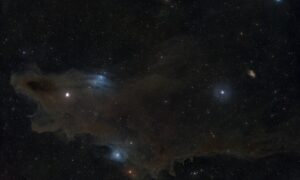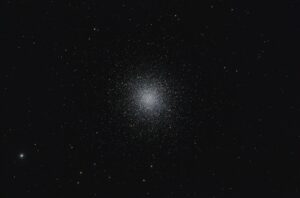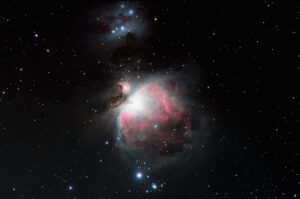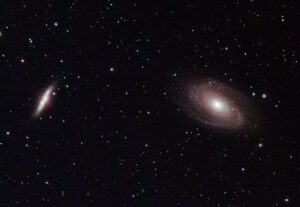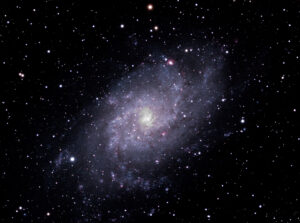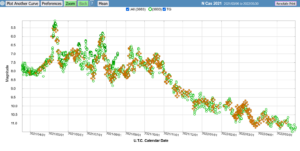Stars, moon and planets can be easily seen in the sky even with an unarmed eye and radiate their own fascination. However, objects that are very far away and thus appear particularly faint, or objects that radiate in wavelengths that are only very faintly perceptible to the human eye, can only be observed if a correspondingly large aperture is used so that as many of the emitted photons as possible can be collected. Since more and more interfering photons (light pollution) are captured with a large aperture, filters must therefore be used that allow the desired wavelengths to pass through and attenuate the interfering ones. In addition, cameras are used which, unlike the human eye, also detect wavelengths that make the recognition of corresponding structures possible in the first place (e.g. H-alpha light at approx. 656.3nm). Thanks to these technical aids, very distant or very faint structures such as other galaxies, Quasars or clouds of matter and the exploration of the "cosmic depths" becomes possible – that’s what we call deep sky ...
Reports on such deep sky objects are presented here.
- The World of Dark Nebulae The vast majority of astrophotos show luminous objects such as galaxies, stars, luminous nebulae or supernova remnants. This is about dark nebulae, which appear dark with their dust and gas and are all the more difficult to spot, although they are all the more interesting as the origin of the stars. Beverly Lynds, who made an invaluable contribution in this field, is remembered.
- Globular clusters – fascinating and ancient giantsGlobular clusters turn out to be true jewel boxes in the night sky when magnified appropriately in the telescope. Hundreds of thousands or even millions of stars standing together in a spherical structure in one spot – often up to over 30,000 light-years away from us. But what exactly are globular clusters and are they all the same?
- The UV source in the “Bahamas” and star birth in the “Gulf of Mexico” – The North American Nebula NGC 7000On October 25th and 27th, 2024, the author photographed the North American nebula from an urban garden. Its appearance gives the nebula its name. The article is less about its appearance and more about some of the astrophysical properties of the nebula and the objects within it.
- T Coronae Borealis – The Nova in the futureA star in the constellation Northern Crown is described, for which a drastic increase in brightness is expected this year 2024. The historical events of this nova are discussed, but above all the current state of knowledge about this star, which lights up regularly about every 80 years.
- De Mairan's Nebula - M 43The De Mairan Nebula, which is directly adjacent to the Great Orion Nebula, is often not mentioned at all when observing the entire region around the constellation Orion. But it may be the cause of the spectacularly glowing HII regions on the Sword of Orion.
- The Horsehead Nebula in Orion - B33The closest active star-forming region to Earth is in the constellation Orion in the so-called Horsehead Nebula. Over the past two decades, a great deal of research has been done to understand its structural structure and the mechanisms at work within it.
- The Orion Nebula – M42The Orion Nebula or M42 is probably one of the most striking and therefore well-known deep sky objects in the nighttime winter sky.
- The Cirrus Nebula in SwanAn image of the Cirrus Nebula with a total exposure time of over four hours is presented. The location of the recording was in the urban area of Osnabrück, which was badly affected by artificial lighting. Nevertheless, the fine structures of this object could be imaged.
- Whirlpool galaxy (M51)The image shown is composed of several images from different projects: variable measurement, exoplanet measurement, etc. in the period from 2015 to 2020
- Inside and outside our Milky WayColor images with the mono camera QHY268M are shown. For this purpose, Fab filters are also used. The particular challenge was that one object stood above the bright city center of Osnabrück and the other object was very disturbed by the moon with 70% illuminated area.
- Impressions of the WHAT 2022Over the Westhavelland Star Park you can find obne of the darkest skies in Germany. This reputation was confirmed again this year at the 11th Westhavelländer Astrotreff (26th to 30th August 2022). At this meeting, astronomers from all over Germany come together to observe and exchange ideas together. Our own impressions at this meeting are presented here.
- Objects of the southern skyIn Namibia, far away from civilization and thus all artificial lights, there is the Astro-Farm Rooisand. Here, from May 26th to June 1st 2022 many photos of objects of the southern sky were taken. A selection is presented.
- The Nova V1405 CAS in CassiopeiaThe observation of the Nova V1405 CAS is described. Brightness measurements were carried out over a longer period of time, from April 1st, 2021 to May 15th, 2022. Together with measurements from other international authors, an atypical behavior for a nova was demonstrated.
